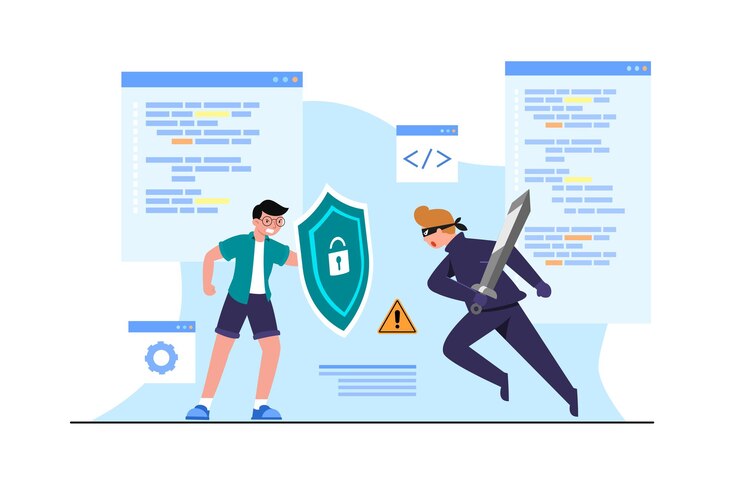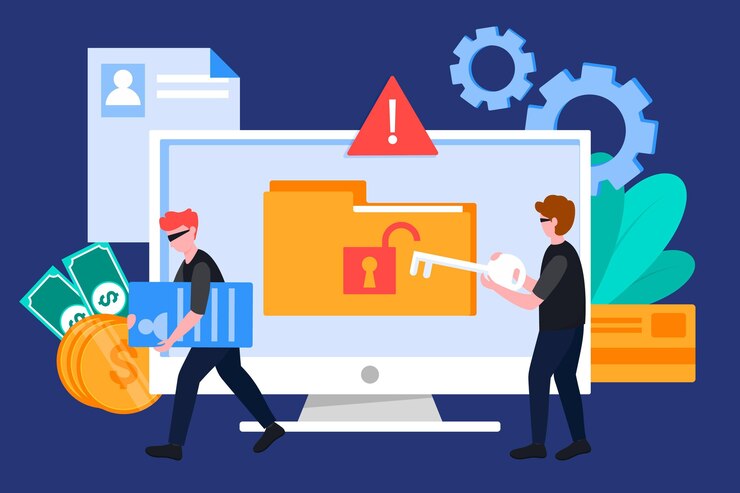
As digital technology advances, so do the methods employed by cybercriminals. Protecting digital information and systems from unauthorized access, breaches, and attacks is a critical concern for individuals and organizations alike. This article explores the various cybersecurity threats, the issues associated with them, and the risks involved in maintaining robust digital security.
Common Cybersecurity Threats
- Phishing Attacks Phishing is a social engineering attack where attackers deceive individuals into providing sensitive information, such as usernames, passwords, or financial details.
- Email Phishing: Attackers send fraudulent emails that appear to be from legitimate sources, often containing malicious links or attachments designed to steal information or infect systems with malware.
- Spear Phishing: A more targeted form of phishing, where attackers customize their messages to specific individuals or organizations, often leveraging personal information to increase the likelihood of success.
- Whaling: A type of spear phishing aimed at high-profile individuals, such as executives or senior managers, with the goal of obtaining highly sensitive information or financial gain.
- Malware Malware, short for malicious software, refers to any software designed to harm or exploit computer systems and networks.
- Viruses: Malicious programs that attach themselves to legitimate files or programs and spread to other systems, often corrupting data or causing system failures.
- Ransomware: A type of malware that encrypts a victim’s files or locks their system, demanding a ransom payment for the decryption key or system unlock.
- Spyware: Software that secretly monitors and collects information about a user’s activities without their knowledge, often for malicious purposes like identity theft or fraud.
- Denial-of-Service (DoS) Attacks DoS attacks aim to disrupt the normal functioning of a targeted system, network, or service by overwhelming it with excessive traffic or requests.
- Traditional DoS Attacks: Flood a system with traffic to exhaust its resources and make it unavailable to legitimate users.
- Distributed Denial-of-Service (DDoS) Attacks: Utilize multiple compromised systems, often part of a botnet, to launch a coordinated attack, making it more difficult to mitigate and defend against.
- Man-in-the-Middle (MitM) Attacks MitM attacks involve an attacker intercepting and potentially altering communication between two parties without their knowledge.
- Eavesdropping: An attacker intercepts and monitors communications to collect sensitive information, such as login credentials or financial data.
- Session Hijacking: An attacker takes control of an active session between a user and a server, potentially gaining unauthorized access to sensitive data or systems.
- SSL Stripping: An attacker downgrades secure HTTPS connections to unsecured HTTP, intercepting and manipulating data transmitted between the user and the website.
- SQL Injection SQL injection is a vulnerability that allows attackers to execute malicious SQL queries on a database, often through user input fields on a website or application.
- Data Theft: Attackers can access and extract sensitive data from the database, such as user credentials, financial records, or personal information.
- Data Manipulation: Attackers can modify or delete data in the database, potentially causing data loss or corruption.
- System Compromise: Exploiting SQL injection vulnerabilities can also allow attackers to gain unauthorized access to the underlying server or system.
- Zero-Day Exploits Zero-day exploits target vulnerabilities in software or hardware that are unknown to the vendor or have not yet been patched.
- Unknown Vulnerabilities: Attackers exploit newly discovered vulnerabilities before developers have a chance to release security updates or patches.
- Limited Detection: Zero-day attacks are challenging to detect and defend against, as there are no existing defenses or signatures for the vulnerability.
- Insider Threats Insider threats involve malicious or negligent actions by individuals within an organization who have access to sensitive information or systems.
- Malicious Insiders: Employees or contractors who intentionally misuse their access to steal, damage, or sabotage data and systems for personal gain or revenge.
- Negligent Insiders: Individuals who inadvertently compromise security through careless actions, such as falling for phishing scams or mishandling sensitive data.
Issues and Risks Associated with Cybersecurity Threats
- Data Breaches Data breaches occur when unauthorized individuals gain access to sensitive or confidential information, leading to potential data theft, exposure, or loss.
- Financial Loss: Organizations may incur significant financial losses due to theft of financial information, legal penalties, and remediation costs.
- Reputation Damage: Data breaches can damage an organization’s reputation, eroding trust among customers, partners, and stakeholders.
- Legal and Compliance Risks: Organizations may face legal consequences and regulatory fines for failing to protect sensitive data and comply with data protection laws and regulations.
- Financial Impact Cybersecurity threats can have substantial financial implications for individuals and organizations, including:
- Ransom Payments: Costs associated with paying ransoms to recover encrypted data or unlock systems.
- Legal Fees: Expenses related to legal proceedings, regulatory fines, and settlements resulting from cybersecurity incidents.
- Operational Disruption: Financial losses due to disrupted business operations, downtime, and recovery efforts following an attack.
- Operational Disruption Cybersecurity incidents can disrupt normal business operations, leading to:
- Service Interruptions: Downtime or unavailability of critical services and applications, impacting customer satisfaction and business continuity.
- Data Loss: Loss of important data due to attacks like ransomware or system failures, affecting productivity and decision-making.
- System Downtime: Time required to recover from attacks or breaches, leading to reduced operational efficiency and increased costs.

- Reputation Damage The impact of cybersecurity threats on an organization’s reputation includes:
- Loss of Customer Trust: Customers may lose confidence in an organization’s ability to protect their data, leading to a loss of business and revenue.
- Negative Publicity: Media coverage of cybersecurity incidents can harm an organization’s public image and brand reputation.
- Competitive Disadvantage: Competitors may leverage an organization’s cybersecurity failures to gain a market advantage or highlight their own security strengths.
- Legal and Regulatory Consequences Organizations may face legal and regulatory repercussions due to cybersecurity threats, such as:
- Compliance Violations: Failure to adhere to data protection regulations (e.g., GDPR, CCPA) may result in fines and legal actions.
- Litigation Costs: Expenses related to lawsuits filed by affected parties or regulatory bodies following a data breach or security incident.
- Regulatory Fines: Financial penalties imposed by regulatory authorities for non-compliance with cybersecurity standards and requirements.
Mitigating Cybersecurity Risks
- Implementing Security Measures
- Firewalls and Antivirus Software: Use firewalls and antivirus solutions to protect against unauthorized access and malware.
- Encryption: Encrypt sensitive data in transit and at rest to protect it from unauthorized access and breaches.
- Multi-Factor Authentication (MFA): Implement MFA to enhance security by requiring multiple forms of verification for accessing systems and accounts.
- Conducting Regular Security Training
- Employee Awareness: Provide ongoing training to employees on cybersecurity best practices, phishing prevention, and safe handling of sensitive information.
- Incident Response: Educate employees on how to recognize and report potential security incidents or breaches.
- Maintaining Up-to-Date Systems
- Patching and Updates: Regularly update software and systems with the latest security patches to address known vulnerabilities and reduce the risk of exploitation.
- Vulnerability Assessments: Conduct periodic vulnerability assessments and penetration testing to identify and address potential security weaknesses.
- Developing an Incident Response Plan
- Incident Management: Establish a formal incident response plan outlining procedures for detecting, responding to, and recovering from cybersecurity incidents.
- Communication Plan: Develop a communication strategy for informing stakeholders, customers, and regulatory authorities about security incidents and response efforts.
- Monitoring and Auditing
- Security Monitoring: Implement continuous monitoring solutions to detect and respond to suspicious activities and potential threats in real-time.
- Audit Trails: Maintain detailed logs and audit trails of system activities to facilitate investigation and analysis of security incidents.
Conclusion
Cybersecurity threats pose significant risks to digital information and systems, impacting data security, financial stability, operational efficiency, and organizational reputation. Understanding common threats such as phishing, malware, DoS attacks, and insider threats is crucial for developing effective security strategies. By implementing robust security measures, conducting regular training, maintaining up-to-date systems, and developing comprehensive incident response plans, individuals and organizations can better protect themselves against the evolving landscape of cybersecurity threats and safeguard their digital assets.

[…] Introduction to Insurance […]
[…] Overview of PhonePe and Google Pay […]
[…] The tech field is rapidly evolving, requiring professionals to stay updated with the latest trends, tools, and […]
[…] A system running Ubuntu (version 20.04 or later is recommended) […]
[…] Mortgage Loans […]